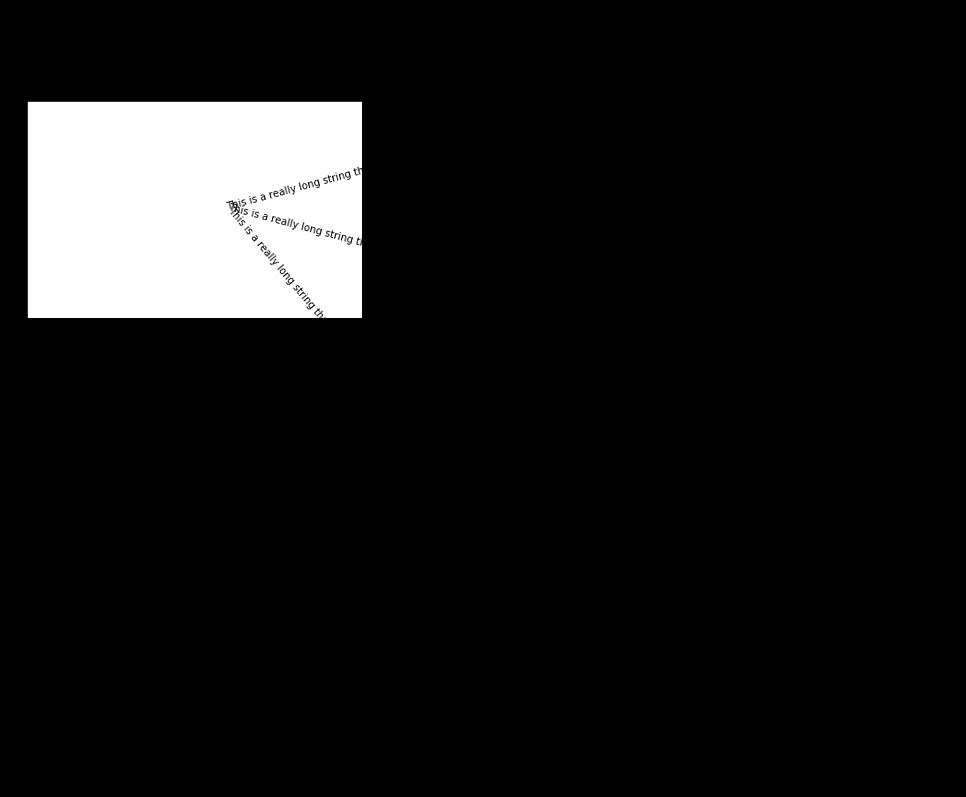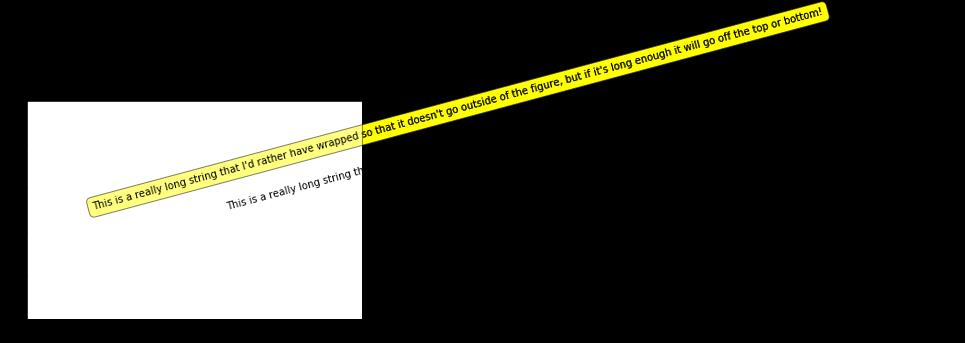plt.text()函数解析(最清晰的解释)
Posted 我是管小亮
tags:
篇首语:本文由小常识网(cha138.com)小编为大家整理,主要介绍了plt.text()函数解析(最清晰的解释)相关的知识,希望对你有一定的参考价值。
欢迎关注WX公众号:【程序员管小亮】
plt.text()函数用于设置文字说明。
plt.text(x,
y,
string,
fontsize=15,
verticalalignment="top",
horizontalalignment="right"
)
参数:
-
x,y:表示坐标值上的值
-
string:表示说明文字
-
fontsize:表示字体大小
-
verticalalignment:垂直对齐方式 ,参数:[ ‘center’ | ‘top’ | ‘bottom’ | ‘baseline’ ]
-
horizontalalignment:水平对齐方式 ,参数:[ ‘center’ | ‘right’ | ‘left’ ]
-
xycoords选择指定的坐标轴系统:
- figure points:图左下角的点
- figure pixels:图左下角的像素
- figure fraction:图的左下部分
- axes points:坐标轴左下角的点
- axes pixels:坐标轴左下角的像素
- axes fraction:左下轴的分数
- data:使用被注释对象的坐标系统(默认)
- polar(theta,r):if not native ‘data’ coordinates t
-
arrowprops #箭头参数,参数类型为字典dict
- width:箭头的宽度(以点为单位)
- headwidth:箭头底部以点为单位的宽度
- headlength:箭头的长度(以点为单位)
- shrink:总长度的一部分,从两端“收缩”
- facecolor:箭头颜色
-
bbox给标题增加外框 ,常用参数如下:
- boxstyle:方框外形
- facecolor:(简写fc)背景颜色
- edgecolor:(简写ec)边框线条颜色
- edgewidth:边框线条大小
例子1:
import matplotlib.pyplot as plt
fig = plt.figure()
plt.axis([0, 10, 0, 10])
t = "This is a really long string that I'd rather have wrapped so that it"\\
" doesn't go outside of the figure, but if it's long enough it will go"\\
" off the top or bottom!"
plt.text(4, 1, t, ha='left', rotation=15, wrap=True)
plt.text(6, 5, t, ha='left', rotation=15, wrap=True)
plt.text(6, 5, t, ha='left', rotation=15, wrap=False)
plt.show()

(x,y)参数是句子头的坐标。
例子2:
import matplotlib.pyplot as plt
fig = plt.figure()
plt.axis([0, 10, 0, 10])
t = "This is a really long string that I'd rather have wrapped so that it"\\
" doesn't go outside of the figure, but if it's long enough it will go"\\
" off the top or bottom!"
plt.text(6, 5, t, ha='left', rotation=15, wrap=True)
plt.text(6, 5, t, ha='left', rotation=-15, wrap=True)
plt.text(6, 5, t, ha='left', rotation=-50, wrap=True)
plt.show()

- ha为’left’参数, rotation>0的时候,句子头这一侧更低。
- ha为’left’参数, rotation<0的时候,做上面的1的关于水平坐标轴的镜像。
- rotation参数是和水平坐标轴的夹角。
例子3:
import matplotlib.pyplot as plt
fig = plt.figure()
plt.axis([0, 10, 0, 10])
t = "This is a really long string that I'd rather have wrapped so that it"\\
" doesn't go outside of the figure, but if it's long enough it will go"\\
" off the top or bottom!"
plt.text(6, 5, t, ha='left', rotation=15, wrap=True)
plt.text(5, 10, t, fontsize=18, style='oblique', ha='center',va='top',wrap=True)
plt.show()

fontsize,style,ha,va参数分别是字号,字体,垂直对齐方式,水平对齐方式。
例子4:
import matplotlib.pyplot as plt
fig = plt.figure()
plt.axis([0, 10, 0, 10])
t = "This is a really long string that I'd rather have wrapped so that it"\\
" doesn't go outside of the figure, but if it's long enough it will go"\\
" off the top or bottom!"
plt.text(6, 5, t, ha='left', rotation=15, wrap=True)
plt.text(4, 4, t, family='serif', style='italic', ha='right', wrap=True)
plt.text(4, 6, t, style='italic', ha='right', wrap=True)
plt.show()

family参数应该是一个字体参数。
例子4:
import matplotlib.pyplot as plt
fig = plt.figure()
plt.axis([0, 10, 0, 10])
t = "This is a really long string that I'd rather have wrapped so that it"\\
" doesn't go outside of the figure, but if it's long enough it will go"\\
" off the top or bottom!"
plt.text(6, 5, t, ha='left', rotation=15, wrap=True)
plt.text(2, 5, t, ha='left', rotation=15, wrap=True, bbox=dict(boxstyle='round,pad=0.5', fc='yellow', ec='k',lw=1 ,alpha=0.5))
plt.show()

这个参数和plt.annotate()一样。
python课程推荐。

以上是关于plt.text()函数解析(最清晰的解释)的主要内容,如果未能解决你的问题,请参考以下文章